3 Prevention of Illness
Learning Objectives
By the end of this chapter, you should be able to:
- Describe each of the five ways illness is transmitted.
- Explain how immunization prevents illness.
- Identify standard precautions to prevent illness.
- Discuss practices to protect children from environmental hazards.
 |
Licensing Regulations WAC regulations that relate to this chapter include:
110-300-0205: Child, staff, and household member illness
110-300-0420: Prohibited substances
110-300-0240: Clean and healthy environment
110-300-0140: Room arrangement, child-related displays, private space, and belongings
110-300-0265: Sleep, rest, and equipment
|
|---|
Introduction
Science and experience tell us that infectious disease, especially gastrointestinal disease, which means vomiting and diarrhea, and respiratory disease, including coughs, colds, sore throats, and runny noses, are increased among children who are cared for in out-of-home group settings. In addition, such children may be at increased risk for certain other infections that may be transmitted by insects or by body fluids. It’s also true that children who are cared for in group out-of-home settings are more likely to experience infectious illnesses that are more severe and more prolonged (although 90% of those infections are mild and self-limited, requiring no special treatment).
But there’s good news, too. Infectious illnesses such as pneumonia and influenza, which together were the leading causes of death among U.S. children in the early 20th century, have declined 99.7 percent. Common childhood illnesses such as diphtheria, whooping cough, measles, mumps, and rubella are rare except in communities where immunization rates are low, and polio is unheard of in our country today.
Although younger children are more susceptible to infectious illness because their immune systems are immature, as they grow older, the incidences of infectious disease decrease as their immune systems mature. Furthermore, children who experience more infectious disease at an early age in group out-of-home care have a decreasing incidence of infectious disease as they grow older. In fact, they have less infectious illnesses in kindergarten than children who were taken care of exclusively at home. Illness also decreases with years of attendance in out-of-home early care and education settings.
There are negative consequences of childhood illness, including:
- It’s unpleasant to be sick (for children or the adults that may also become infected).
- Illnesses that are minor in children can be much more serious for adults and pregnant women.
- Some illnesses have severe effects (and can even be life-threatening).
- There are short-term medical costs.
- There may also be additional childcare costs or lost wages for parents/caregivers of children that must be excluded from group care.
- Overuse of antibiotics to get children well contributes to antibiotic resistance among common bacteria.
To prevent illness, we need to understand the different ways illness is spread, how immunizations protect children, and what universal precautions early care and education program staff can take to prevent the spread of illness.
How Illnesses are Transmitted
Bacteria, viruses, fungi, and parasites that cause illness can be transmitted in five ways, including through:
- the respiratory route
- the fecal-oral route
- the direct contact route
- the bodily fluid route (including blood, urine, vomit, and saliva)
- the vector-borne route
Respiratory Transmission
Most respiratory germs stay in the nose, sinuses, mouth and throat, or possibly the middle ear. Upper respiratory illnesses (colds) are the most common and the most likely to be transmitted in early care and education settings.
The more common respiratory illnesses include:
- Sinusitis
- Sore throat
- Common cold
- Recurrent middle ear infection
- Strep throat
- RSV
- Pneumonia
- Bronchitis
Pneumonia and bronchitis are rarely the result of an infection picked up in an early education setting. We also have immunizations for many respiratory diseases that are rarely transmitted in early care and education settings today, including:
- Mumps
- Measles
- Bacterial meningitis
- Chicken pox
- Diphtheria
- Pertussis
- Pneumonia
- Seasonal flu
If we could see what comes out of a child’s mouth along with a cough or sneeze, we might appreciate the respiratory route of infectious disease transmission more.
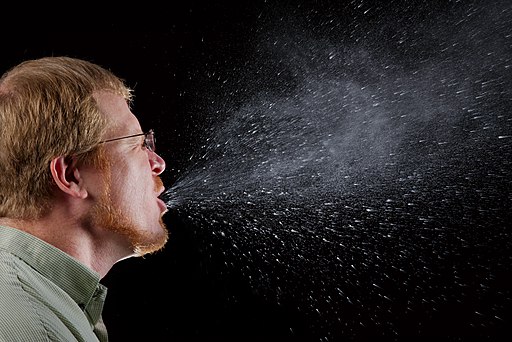
The germs that are in this contaminated cloud of exhalation can land on a variety of surfaces and hands, then be transmitted to others. Staff and children who can are encouraged to cough into their sleeves: covering your mouth with your hand only transfers these germs to your hand. Adults and children who are able should wear masks to protect others from germs in their coughs and sneezes.
Fecal-Oral Transmission
When organisms that live in our intestines get into our mouths, they can cause illness. Usually, this happens via someone’s hands, usually our own. Fecal-oral routes diseases include:
- Hepatitis A
- diarrhea
- hand, foot, and mouth disease
- pinworms
- rotavirus
- norovirus
- giardia
- shigella
- cryptosporidiosis
That is why it is so important that everyone washes their hands after using the bathroom, changing diapers, when preparing food, and before eating.
Food Poisoning
E. coli and salmonella are two of the germs that you may also have heard mentioned in the news when grocery stores send back fresh vegetables, meat, or poultry. These organisms originate from farm animals and can cause diarrhea and vomiting if children or staff eat contaminated food. Properly preparing and serving fresh produce, meat, and poultry is essential to prevent food poisoning.
Direct Contact Transmission
Direct contact with another person’s skin (or hair) puts infants and children at risk of illnesses such as:
- cold sores
- conjunctivitis
- pink eye
- impetigo
- lice
- scabies
- ringworm (a fungus, not a worm)
Bodily Fluid Transmission
Bodily fluids, including saliva, urine, vomit, and blood, can cause illness, such as:
- Dental caries (by saliva)
- Cytomegalovirus or CMV (by urine)
- Hepatitis B (preventable by vaccine)
- Hepatitis C (rare in children)
- HIV (no cases of transmission in an early education setting)
Vector-Borne Transmission
A vector-borne disease is transmitted from a living organism between humans or from animal to human, usually through a bite and blood meal. The best examples of vectors are mosquitoes, fleas, and ticks. We know, for example, that ticks can transmit Lyme disease and Rocky Mountain spotted fever. Fleas are known to transmit Bubonic plague and typhus. Mosquitoes can infect people with St. Louis encephalitis (SLE), dengue fever, Zika virus, and West Nile disease. Rats and mice can transmit leptospirosis, trichinosis, hantavirus, and bacterial food poisoning. Raccoons can spread raccoon roundworm.
While these illnesses are relatively uncommon, the risk reminds us of the importance of:
- utilizing integrated pest management techniques to keep insects and rodents out of buildings.
- using insect repellant specifically recommended for children during outdoor activities.
- removing standing water in which mosquitoes can lay their eggs.
- checking for and removing ticks when children come back in after playing in or near heavily wooded areas[1]
 |
Reflective Practice Why is it important to understand how illnesses and diseases are spread? |
|---|
Immunizations
Prevention of infectious disease starts with immunizations (or vaccines). Immunizations are considered the number one public health intervention of the 20th century and one of the top 10 interventions of the first decade of the 21st century.[2]
On-time vaccination throughout childhood is essential because it helps provide immunity before children are exposed to potentially life-threatening diseases. Vaccines are tested to ensure that they are safe and effective for children to receive at the recommended ages.91 See Figure 3.2 for the current schedule of immunizations.
Fully vaccinated children in the U.S. are protected against sixteen potentially harmful diseases (see Figure 3.2). Vaccine-preventable diseases can be very serious, may require hospitalization, or even be deadly — especially in infants and young children.[3]
Here is the schedule from the CDC to ensure a child is fully vaccinated:
How Vaccines Work
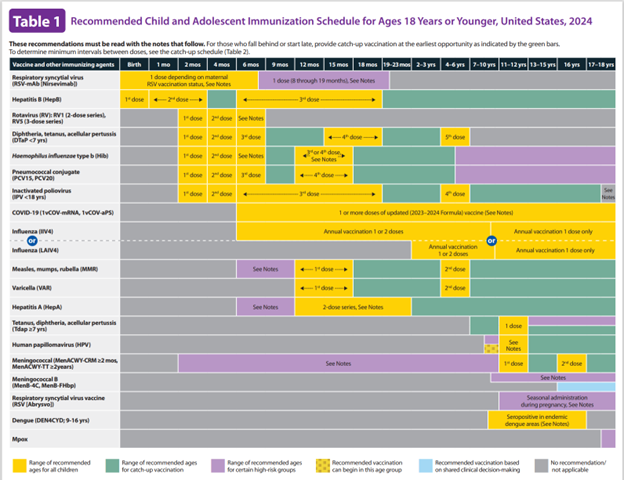
The immune system helps the human body fight germs by producing substances to combat them. Once it does, the immune system “remembers” the germ and can fight it again. Vaccines contain germs that have been killed or weakened. When given to a healthy person, the vaccine triggers the immune system to respond and thus build immunity.
Before vaccines, people became immune only by getting a disease and surviving it. Vaccines are the best defense we have against serious, preventable, and sometimes deadly contagious diseases. Vaccines are some of the safest medical products available, but like any other medical product, there may be risks. Accurate information about the value of vaccines as well as their possible side effects helps people to make informed decisions about vaccination.
Potential Side Effects
Vaccines, like all medical products, may cause side effects in some people. Most of these side effects are minor, such as redness or swelling at the injection site. Any vaccine can cause side effects. For the most part, these are minor (for example, a sore arm or low-grade fever) and go away within a few days.[4] Adverse, or serious side effects, after vaccination, such as severe allergic reaction, are very rare.[5]
How Well Do Vaccines Work?
Vaccines effectiveness is measured by how well a vaccine protects populations against infections, illness, hospitalization, and death. It is also measured by comparing the health outcomes of vaccinated and unvaccinated people.
All vaccines must be licensed (approved) by the Food and Drug Administration (FDA) before being used in the United States. Vaccines must go through extensive testing, both in a laboratory and in clinical trials, to make sure the vaccine is safe, effective, pure, and potent before the FDA will approve it. Clinical trials compare groups of people who get the actual vaccine with groups of people who get a placebo (harmless substitute). A vaccine is approved only if FDA makes the determination that it is safe and effective for its intended use.[6]
What about the argument made by some people that vaccines don’t work that well and diseases would be go away on their own because of better hygiene or sanitation, even if there were no vaccines? This simply isn’t true. Certainly, better hygiene and sanitation can help prevent the spread of disease, but the germs that cause disease will still be around and still make people ill.
If you look at the history of any vaccine-preventable disease, you will virtually always see that the number of cases of disease starts to drop when a vaccine is introduced. Vaccines are the most effective tool we have for prevent infectious diseases. You may have herd the term “herd immunity.” Herd immunity refers to the suppression of the spread of an infectious disease based on the high level of immunity in the population through previous infection or vaccination.
Opposition to Vaccines
In 2019, there were 2 measles outbreaks in Washington State that sickened 90 people.[7] The outbreak lasted from January through August: the first from January through April and the second from May to August. A State of Emergency was declared by the governor on January 25th, 2019, regarding the outbreak and the danger it posed to unvaccinated populations and vulnerable populations. The vaccination rate in the county that was the epicenter of the outbreak was 78% and the Pacific Northwest as a whole, had the lowest vaccination rates in the country.[8]
Measles is a highly contagious, vaccine preventable disease spread through respiratory droplets from throat and nasal mucus through coughing and sneezing. The measles virus can live for up to 2 hours in the air and can infect up to 90% of people who encounter the airspace of an infected person.[9] Symptoms begin within 7-14 days (about 2 weeks) after exposure and include high fever, cough, runny nose, and red, watery eyes. Within 3-5 days of symptoms beginning, the infected person breaks out in a rash that usually starts at the hairline and travels down the rest of the body.[10] Measles is especially dangerous for children under 5, adults over 20, pregnant persons, and people with compromised immune systems. Severe complications from the measles include pneumonia, encephalitis, and death.[11]
What about people who do not want their children to have vaccines? That question is at the heart of a debate that has been simmering for years. Vaccines are biological preparations that improve immunity against a certain disease. Vaccines have contributed to the eradication and weakening of numerous infectious diseases, including smallpox, polio, mumps, chickenpox, and meningitis.
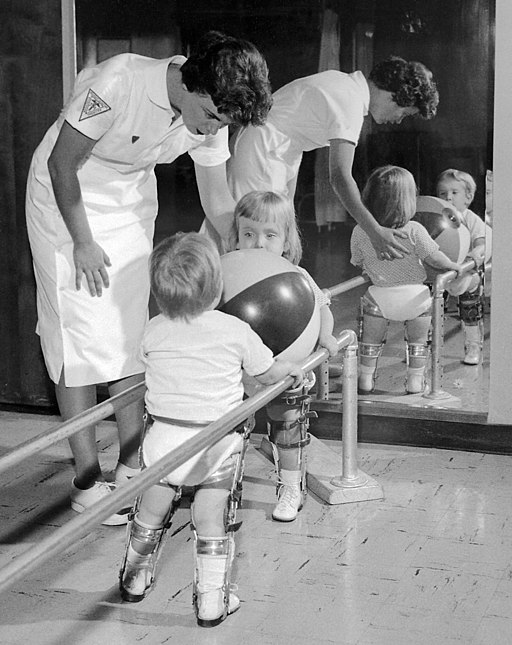
However, many people express concern about the potential negative side effects of vaccines. These concerns range from fears about overloading the child’s immune system to controversial reports about devastating side effects of the vaccines.[12]
Although children continue to get several vaccines up to their second birthday, these vaccines do not overload the immune system. Every day, an infant’s healthy immune system successfully fights off thousands of antigens – the parts of germs that cause their immune system to respond. Even if your child receives several vaccines in one day, vaccines contain only a tiny number of antigens compared to the antigens your baby encounters every day.
This is the case even if your child receives combination vaccines. Combination vaccines take two or more vaccines that could be given individually and put them into one shot. Children get the same protection as they do from individual vaccines given separately—but with fewer shots.[13]
One misapprehension is that the vaccine itself might cause the disease it is supposed to be immunizing against.[14] Vaccines help develop immunity by imitating an infection, but this “imitation” infection does not cause illness. Instead, it causes the immune system to develop the same response as it does to a real infection so the body can recognize and fight the vaccine-preventable disease in the future. Sometimes, after getting a vaccine, the imitation infection can cause minor symptoms, such as fever. Such minor symptoms are normal and should be expected as the body builds immunity.[15]
Another commonly circulated concern is that vaccinations, specifically the MMR vaccine (MMR stands for measles, mumps, and rubella), are linked to autism. The autism connection has been particularly controversial. In 1998, a British physician named Andrew Wakefield published a study in Great Britain’s Lancet magazine that linked the MMR vaccine to autism. The report received a lot of media attention, resulting in British immunization rates decreasing from 91 percent in 1997 to almost 80 percent by 2003, accompanied by a subsequent rise in measles cases (Devlin 2008). A prolonged investigation by the British Medical Journal proved that not only was the link in the study nonexistent, but that Dr. Wakefield had falsified data to support his claims (CNN 2011). Dr. Wakefield was discredited and stripped of his license, but the doubt still lingers in many parents’ minds.
In the United States, many parents still believe in the now-discredited MMR-autism link and refuse to vaccinate their children. Other parents choose not to vaccinate for various reasons like religious or health beliefs. In one instance, a boy whose parents opted not to vaccinate returned home to the U.S. after a trip abroad; no one yet knew he was infected with measles. The boy exposed 839 people to the disease and caused 11 additional cases of measles, all in other unvaccinated children, including one infant who had to be hospitalized.
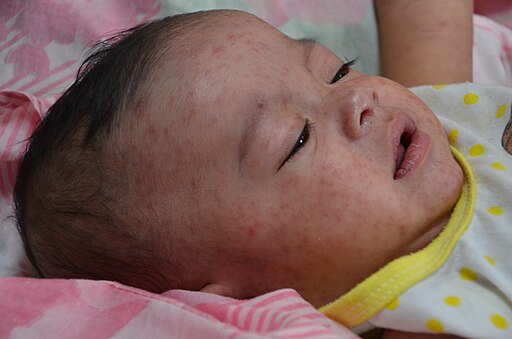
According to a study published in Pediatrics (2010), the outbreak cost the public sector $10,376 per diagnosed case. The study further showed that the intentional non-vaccination of those infected occurred in students from private schools, public charter schools, and public schools in upper-socioeconomic areas (Sugerman et al. 2010).[16]
 |
What about the Flu Vaccine? There are many reasons to get an influenza (flu) vaccine each year. Below is a summary of the benefits of flu vaccination, and selected scientific studies that support these benefits.
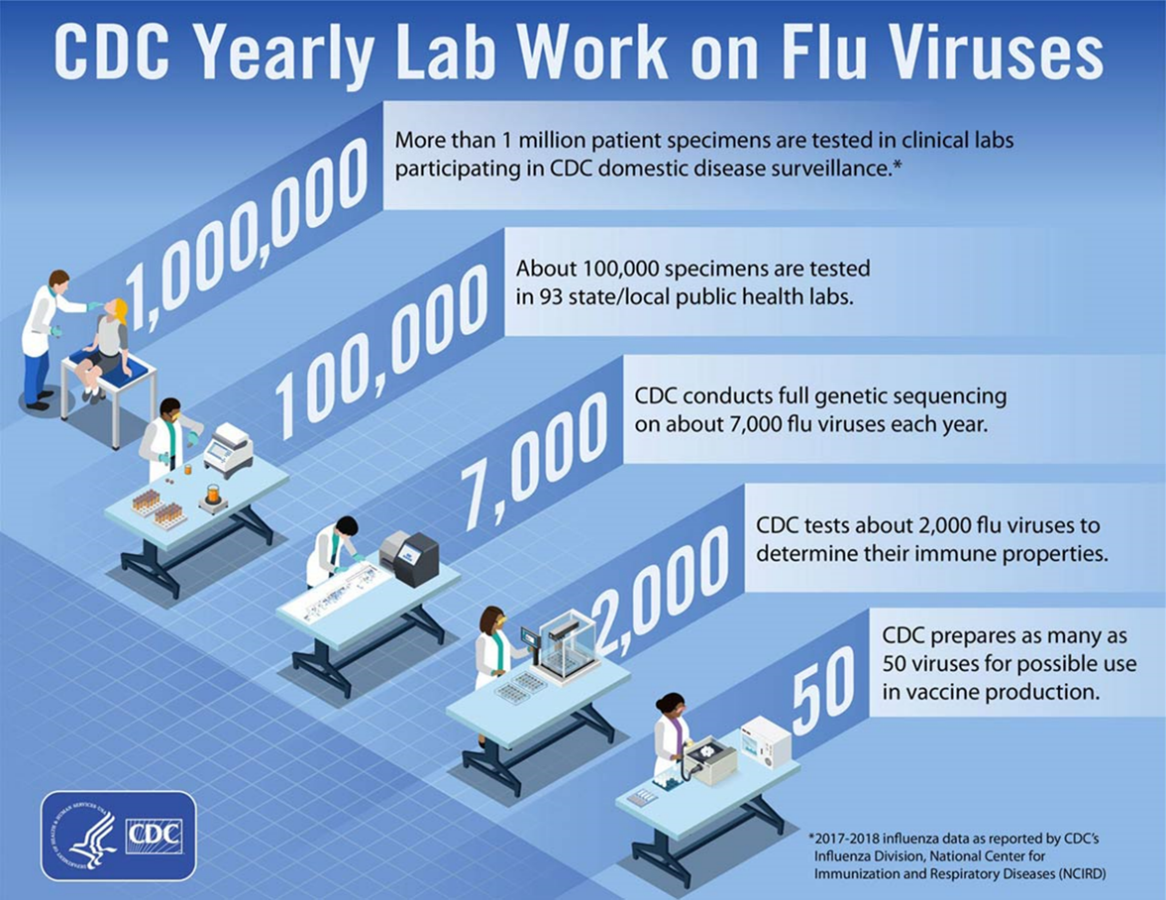 |
|---|
 |
Reflective Practice Using the information that has been provided about immunizations, think of ways you could respond to the following:
|
|---|
Universal Precautions to Prevent the Spread of Illness
There are some standard practices that prevent, or reduce the risk of, the spread of illness in early care and education programs. These are modeled after practices in health care, where everyone is treated as being potentially infected with something that is contagious. Many illnesses are contagious before the infected person is symptomatic, so waiting until you see signs of illness is ineffective in preventing its spread. Childcare providers can practice these four things to help control the spread of illness.
- Hand washing
- Use of disposable nonporous gloves when working with bodily fluids
- Disinfecting potentially contaminated surfaces
- Proper disposal of potentially contaminated waste[18]
Handwashing
Regular handwashing is an important step to minimizing the spread of germs. Hands pick up germs from all the things they touch and then spread them from one place to another. Germs that are on hands can also enter the body when a person eats or when they touch their eyes, nose, mouth, or any area on the body where the skin is broken (because of a cut, rash, etc.).
All that is needed for handwashing is soap and clean, running water. Handwashing with soap and water removes visible dirt and hidden germs. Studies have demonstrated that handwashing reduced the number of diarrheal illnesses by 31 percent and respiratory illnesses by 21 percent.
Hands should be washed:
- before eating, feeding, or preparing food. This prevents germs from getting into the mouth from hands.
- after touching saliva (after feeding or eating), mucus (wiping a nose, using a tissue), bodily fluids (toileting, diapering), food, or animals
- after water or sensory play
- when coming inside from outdoor play
- when visibly dirty, after touching garbage, or after cleaning
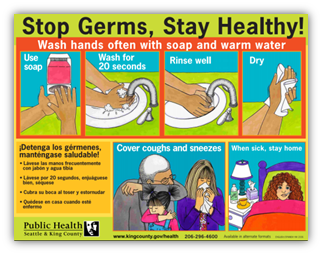
Figure 3.6 King County Public Health flyer on handwashing and staying home when ill.
The Center for Disease Control recommends the following handwashing steps:
- “Wet your hands with clean, running water (warm or cold) and apply soap.”
- “Rub your hands together to make a lather and scrub your hands well; be sure to scrub the backs of your hands, between your fingers, and under your nails.”
- “Continue rubbing your hands for at least 20 seconds. Need a timer? Hum the “Happy Birthday” song from beginning to end twice.”
- “Rinse your hands well under running water.”
- “Dry your hands using a clean towel or air dry them.”
Infants and young children will need help with handwashing. Caring for Our Children recommends that caregivers:
- Safely cradle an infant in one arm to wash their hands at a sink.
- Provide handwashing assistance for young children that cannot wash their hands independently.
- Offer a stepping stool to young children so they may safely reach the sink.[19]
Wearing Disposable Gloves
Teachers and caregivers should wear gloves when they anticipate coming into contact with any of the following (on a child’s body or a contaminated surface)
- Blood or bodily substances (i.e., fluids or solids)
- Mucous membranes (e.g., nasal, oral, genital area)
- Non-intact skin (e.g., rashes or cuts and scrapes)[20]
Once the gloves are soiled, it’s important to remove them carefully:
- Using a gloved hand, grasp the palm area of the other gloved hand and peel off the first glove.
- Hold the removed glove in the gloved hand.
- Slide fingers of the ungloved hand under the remaining glove at the wrist and peel off the second glove over the first glove.
- Discard the gloves in a waste container.[21]
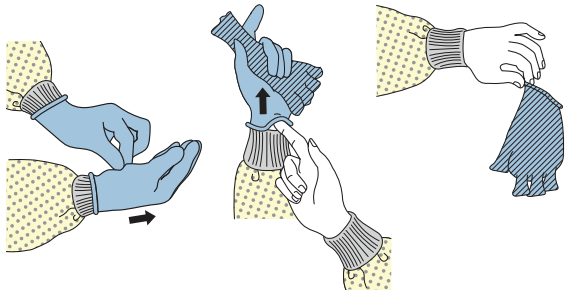
After you remove your gloves, you should wash your hands. “Do not reuse the gloves: this can spread germs from one child to another…Gloves provide added protection from communicable disease only if used correctly. If you use gloves incorrectly, you risk spreading more germs than if you don’t use gloves. Pay attention to your gloving technique so that you do not develop a false sense of security (and carelessness) when wearing gloves.”[22]
Cleaning and Disinfecting
Washing Surfaces Germs spread onto surfaces from hands and objects (tissues or mouthed toys) or from a sneeze or cough. It is important to clean all surfaces well, including toys and any surface that a young child puts in his mouth, because germs cannot be seen, and it is easy to overlook surfaces that do not look soiled or dirty.
Toileting and diapering involve germs from bodily fluids and fecal material. These germs spread easily in a bathroom onto hands, flushers, and faucets. Routinely washing bathroom surfaces removes most germs and prevents them from spreading. The kitchen is another area of the home where it is important to clean surfaces well.
The terms “cleaning,” “sanitizing,” and “disinfecting” deserve close attention.
- Cleaning
- Removes visible soil, dirt, and germs.
- Soap and water will clean most surfaces.
- Sanitizing
- Reduces, but does not totally get rid of, germs to a level that is unlikely to cause disease.
- Sanitizers may be appropriate to use on surfaces where you eat (such as a table or highchair tray) and with toys that children place in their mouths.
- It is important to follow the instructions on the label, which may also include rinsing surfaces after using the sanitizing product.
- Disinfecting
- Destroys or inactivates infectious germs on surfaces.
- Disinfectants may be used on diaper-changing tables, toilets, and counter tops.[23]
Early care and education programs can create a bleach and water solution of one tablespoon household bleach to one quart water for surfaces that need to be sanitized or disinfected. To use effectively, the surface must be wetted with the solution and allowed to air dry. A fresh bleach solution should be made each day to maintain effectiveness and stored in a clearly labeled spray bottle out of children’s reach. Research shows that other chemicals (e.g., ammonia, vinegar, baking soda, Borax) are not effective against some bacteria.119 “Items that can be washed in a dishwasher or hot cycle of a washing machine do not have to be disinfected because these machines use water that is hot enough for a long enough period of time to kill most germs.”[24]
Cleaning and disinfecting are essential. Studies have shown that some germs, including influenza virus, can survive on surfaces for two to eight hours; rotavirus can survive up to 10 days.[25]
Table 3.1 – Guidelines for a Clean and Healthy Childcare Environment[26]
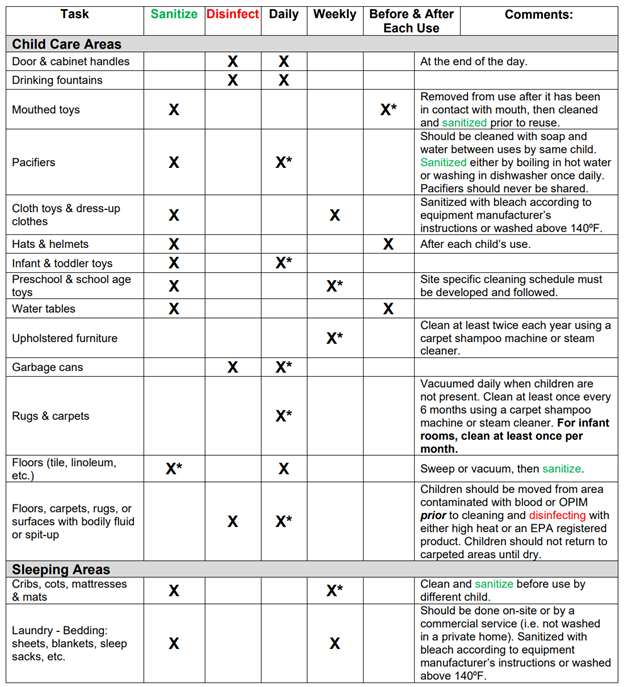
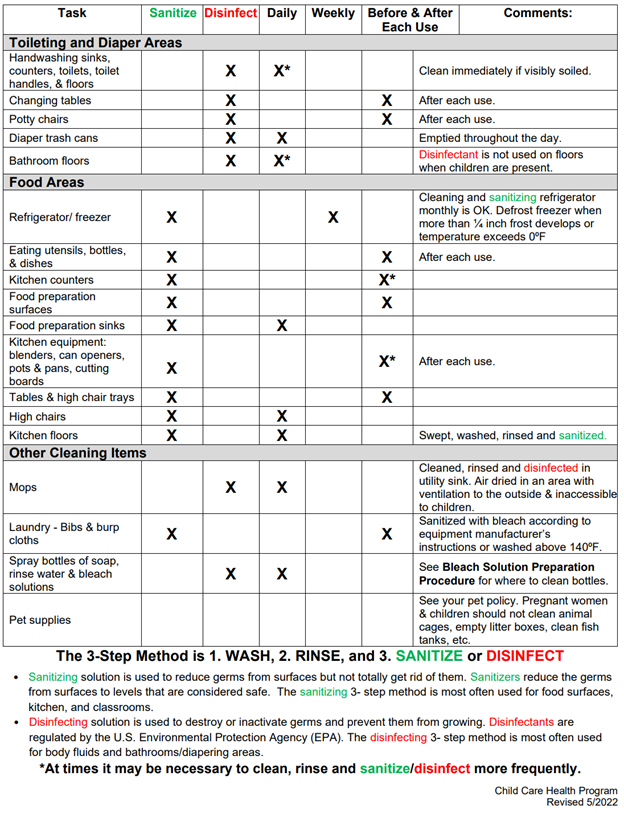
Disposal of Waste
Proper disposal and storage of garbage waste prevents the spread of disease, odors, and problems with pests. Disposable items (diapers, gloves, paper towels, and facial tissues) should be thrown away immediately in an appropriate container. Make sure the container is water and rodent-proof, operated with a foot pedal, is lined with a plastic bag, within reach of diaper changing area, handwashing sink, and food preparation areas, out-of-reach of and unable to be knocked over by infants and toddlers. The containers should be emptied, cleaned, and sanitized daily. [27]
Diaper Changing
Diaper changing areas must[28]:
- Be separate from areas where food is stored, prepared, or served;
- Have a sink with hot and cold running water, not used for food preparation and clean up;
- Have a sturdy surface or mat that:
- Is not torn or repaired with tape;
- Is washable;
- Has a moisture resistant surface that is cleanable; and
- Is large enough to prevent the area underneath the diaper changing area from being contaminated with bodily fluids.
- Be on moisture resistant, washable material that horizontally or vertically surrounds and extends at least two feet from the diaper changing station and handwashing area; and
- Be uncluttered and not used for storage of any items not used in diapering a child.
Children must never be left unattended on a diaper changing surface, never use a safety belt because they are not safe and cannot be properly cleaned and sanitized, post diaper changing procedures that are easily viewable, and prevent the viewing of partially or fully unclothed children during diaper changes to people who are not affiliated with the early learning program.
 |
Reflective Practice You are at a job interview to become a teacher in an infant room and the director asks you what you would do to prevent the spread of illness in your classroom. What might you want to mention? |
|---|
Environmental Health
Air quality, chemical hazards, drinking water, mold, and pest management are all topics early care and education providers should be aware of and following appropriate policies and procedures to limit exposure to environmental hazards.
Outdoor Air Quality
Children are more susceptible to the effects of contaminated air because they breathe in more oxygen relative to their body weight than adults.[29] Therefore, they “can be exposed to a lot of pollution. Children should be kept inside when air quality is poor or should at least be discouraged from intense outdoor activity[30]. Educators and parents should be aware that nearby construction and traffic can increase pollution. Mowing school lawns should never occur during school hours since this can cause an allergy or asthma attack. Insecticides should never be sprayed while children are in care. Outdoor air can include odors, pollutants from vehicles, and fumes from stored trash, chemicals, and plumbing vents.”[31]
Indoor Air Quality
There are so many sources of indoor air pollution in childcare facilities that the air is considered two to five times more polluted than outdoor air. Common sources of indoor air pollution include combustion sources such as oil, gas, kerosene, coal, wood, and tobacco products; building materials and furnishings as diverse as deteriorated, asbestos-containing insulation, wet or damp carpet, and cabinetry or furniture made of certain pressed wood products; products for household cleaning and maintenance, personal care, or hobbies; central heating and cooling systems and humidification devices; and outdoor sources such as radon, pesticides, and outdoor air pollution.[32]
 |
Environmental Tobacco Smoke & Dangers of E-Cigarettes
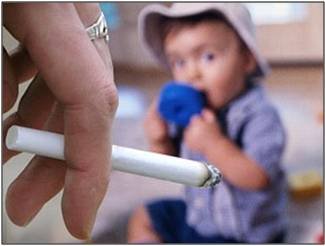 Environmental tobacco smoke (ETS), otherwise known as secondhand smoke, is a mixture of the smoke given off by the burning end of a cigarette, or cigar, and the smoke exhaled by smokers. Secondhand smoke contains more than 4,000 substances, several of which are known to cause cancer. Children are particularly vulnerable to the effects of secondhand smoke because they are still developing physically, have higher breathing rates than adults, and have little control over their environment, including where and when the adults in their world choose to smoke. Exposure to secondhand smoke can cause asthma, and places infants and children at increased risk for Sudden Infant Death Syndrome (SIDS), pneumonia, bronchitis, and middle ear infections.[33]
What About E-Cigarettes? 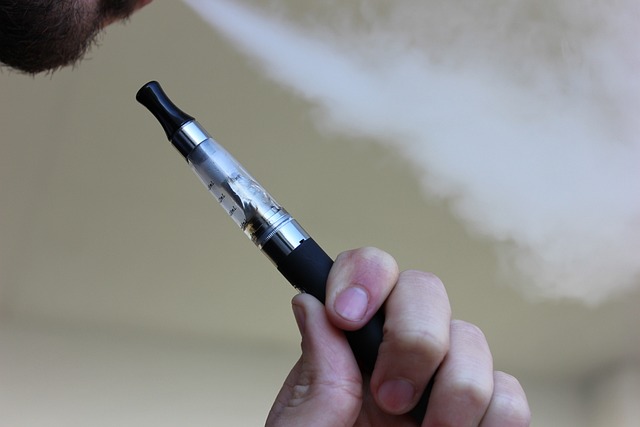 The aerosol from e-cigarettes is not harmless. It can contain harmful and potentially harmful chemicals, including nicotine; ultrafine particles that can be inhaled deep into the lungs; flavoring such diacetyl, a chemical linked to a serious lung disease; volatile organic compounds such as benzene, which is found in car exhaust; and heavy metals, such as nickel, tin, and lead. Scientists are still working to understand more fully the health effects and harmful doses of e-cigarette contents when they are heated and turned into an aerosol, both for active users who inhale from a device and for those who are exposed to the aerosol secondhand. Another risk to consider involves defective e-cigarette batteries that have been known to cause fires and explosions, some of which have resulted in serious injuries. Most of the explosions happened when the e-cigarette batteries were being charged.[34] |
|---|
Mold
Mold is a fungus that thrives indoors when excessive moisture or water accumulates indoors or when moisture problems remain undiscovered or un-addressed. There are molds that can grow on wood, paper, carpet, and foods. There is no practical way to eliminate all mold and mold spores in the indoor environment. The way to control indoor mold growth is to control moisture.
Mold needs to be controlled in childcare settings to avoid possible health impacts for infants and children, including allergic reactions, asthma, and other respiratory issues.[35]
Lead Exposure
Lead is a poison that is very dangerous for young children because of their small size and rapid growth and development. It can cause anemia, learning difficulties, and other medical problems. Children can be exposed to lead through multiple sources[36]:
- Homes built before 1978 – these homes most likely contain lead paint that release lead dust when the paint peels
- Water pipes made from lead
- Family members who work with lead or have been treated for lead poisoning
- Imported ceramic pottery for cooking, storing, or serving food
- Toys and jewelry
- Traditional home remedies and candy
- Lead in soil
Symptoms of Lead Poisoning
Most children with lead poisoning show no symptoms. However, you might notice:
- Developmental delay
- Learning Difficulties
- Irritability
- Headaches
- Poor appetite or stomachache
- Weight loss
- Fatigue and sluggishness
- Slow growth and development
- Vomiting
- Constipation
- Hearing loss
All children with known risk to lead exposure should be screened for lead exposure. This is done through a blood test through either a finger or heel prick or a venous blood draw. In 2021, the Centers for Disease Control and Prevention (CDC) updated the blood lead reference value from 5 μg/dL (micrograms per deciliter) to 3.5 μg/dL based on data and recommendations from the National Health and Nutrition Examination Survey (NHANES). The next steps that need to be taken depend on the levels of lead identified in the blood[37] and should be addressed by a health care provider.
Pest Control and Management
Exposure to pests such as cockroaches, rodents, ants, and stinging insects in childcare centers may place children at risk for disease, asthma attacks, bites, and stings. Improper use of pesticides can also place children at risk. A recent study of pesticide uses in childcare centers revealed that 75% of centers reported at least one pesticide application in the last year. Several factors increase both children’s exposures and their vulnerability to these exposures compared to adults. Children spend more time on the floor, where residues can transfer to skin and be absorbed.
Young children also frequently place their hands and objects in their mouths, resulting in the non-dietary ingestion of pesticides. Children are less developed immunologically, physiologically, and neurologically, and therefore may be more susceptible to the adverse effects of chemicals and toxins. There is increasing evidence of adverse effects of pesticides on young children, particularly on neurodevelopment.[38]
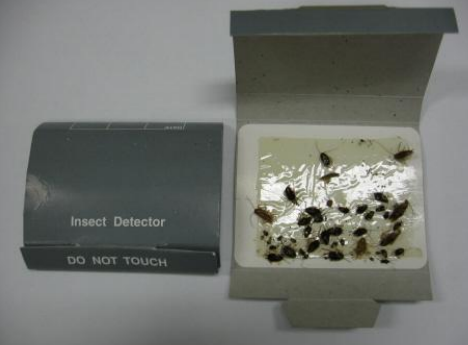
Early learning providers must have a pest control policy and follow these steps for pest control and management[39]:
- Prevention
- Steps are taken to prevent attracting pests including, but not limited to, identifying and removing food and water sources that attract pests.
- Inspection
- Indoor and outdoor areas in and around the licensed space must be inspected for evidence of pests and documentation of the date and location if evidence is found is required.
- Identification
- Pests found in the licensed space must be identified and documented so the pest may be properly removed or exterminated.
- Management
- Document steps taken to remove or exterminate the pests if found in the licensed space.
- Notification
- If pesticides are used, the early learning provider must notify the parents or guardians of enrolled children what pesticide will be applied and where it will be applied no less than forty-eight hours before application, unless in cases of emergency (such as a wasp nest).
- Application
- Pesticide must be applied to early learning program space when children are not present. When pesticide is applied, center providers must comply with chapter 17.21 RCW and family home providers must comply with the pesticide manufacturer’s instructions.
Integrated Pest Management (IPM) is an effective and environmentally sensitive approach to pest management that relies on a combination of common-sense practices. IPM programs use current, comprehensive information on the life cycles of pests and their interaction with the environment.
Integrated Pest Management “(IPM) is a safer, more effective, longer-lasting method of pest control that emphasizes pest prevention by eliminating pests’ access to food, water, and shelter. When using IPM, properly identify the pest and know why it’s there so an appropriate combination of different pest control methods can be used for better effectiveness in controlling the pest.”[40] This information, in combination with the last toxic available pest control methods, is used to manage pest damage by the most economical means, and with the least possible hazard to people, property, and the environment.[41]
Chemical Hazards
A child born today will grow up exposed to more chemicals than a child from any other generation in our nation’s history. Of the 85,000 synthetic chemicals in commerce today, only a small fraction has been tested for toxicity on human health.
A 2005 study found 287 different chemicals in cord blood of 10 newborn babies – chemicals from pesticides, fast food packaging, coals, gasoline emissions, and trash incineration. Children are more vulnerable to toxic chemicals because their bodies are still growing and developing.[42]
Plastics in Child Care Settings
Certain types of plastics contain chemicals such as phthalates, bisphenol A (BPA), polyvinyl chloride (PVC), and polystyrene that may be toxic to children. These plastics can be found in baby bottles, sippy cups, teething rings, pacifiers, and toys. When these items are in a child’s mouth or when they are heated (such as in a microwave), children can be exposed to harmful chemicals that have the potential to mimic or suppress hormones and disrupt normal growth and development.[43]
Drinking Water
The United States has one of the safest public drinking water supplies in the world. Over 286 million Americans get their tap water from a community water system. The US Environmental Protection Agency (EPA) regulates drinking water quality in public water systems and sets maximum concentration levels for water chemicals and pollutants.
Sources of drinking water are subject to contamination and require appropriate treatment to remove disease-causing contaminants. Contamination of drinking water supplies can occur in the source water as well as in the distribution system after water treatment has already occurred. There are many sources of water contamination, including naturally occurring chemicals and minerals (for example, arsenic, radon, uranium), local land use practices (fertilizers, pesticides, concentrated feeding operations), manufacturing processes, and sewer overflows or wastewater releases.
The presence of contaminants in water can lead to adverse health effects, including gastrointestinal illness, reproductive problems, and neurological disorders.[44] Young children are at particular risk for exposure to contaminants in drinking water because, pound for pound, they drink more water than adults (including water used to prepare formula), and because their immature body systems are less efficient at detoxification. Exposure to lead in drinking water is a serious health concern, especially for young children and infants since elevated lead levels in children may result in delays in physical or mental development, lower IQ, and even brain damage.[45]

Under the federal regulations of the Safe Drinking Water Act, all water suppliers must notify consumers quickly when there is a serious problem with water quality. Water systems serving the same people year-round must provide annual consumer confidence reports on the source and quality of their tap water. National drinking water standards are legally enforceable, which means that both U.S. EPA and states can take enforcement actions against water systems not meeting safety standards.[46]
Early learning programs in Washington State need to use a Department of Ecology accredited state certified water laboratory to have their water source tested for lead and copper. All fixtures that provide water for food prep, infant bottles, drinking and cooking must be tested prior to license approval and once every six years after license approval. Programs that use a private well as a water source must comply with state requirements for the well construction and be tested once every 12 months for E. coli bacteria and nitrates.[47]
 |
Reflective Practice What are five important things that early care and education programs should remember about environmental health to keep children healthy? |
|---|
Summary
Understanding how illness spreads help early care and education programs prevent the spread of illness. Immunizations also play an important role in preventing illness. And when program staff use universal precautions, including handwashing, cleaning and disinfecting, and proper disposal of waste, they also prevent the spread of illness.
Programs must also be aware of environmental hazards that present a threat to children’s health. These include both indoor and outdoor air quality, mold, and chemicals. Programs should use integrated pest management and ensure their drinking water is safe.
- Managing Infectious Disease in Head Start Webinar (Transcript) by Head Start Early Childhood Learning & Knowledge Center is in the public domain ↵
- Managing Infectious Disease in Head Start Webinar (Transcript) by Head Start Early Childhood Learning & Knowledge Center is in the public domain ↵
- Vaccines for Your Children: Protect Your Child at Every Age by the CDC is in the public domain ↵
- Possible Side effects from Vaccines | CDC ↵
- ACIP Adverse Reactions Guidelines for Immunization | CDC is in the public domain ↵
- Vaccines | FDA is in the buplic domain. ↵
- Measles 2019 | Washington State Department of Health is in the public domain. ↵
- Health Advisory: Measles Outbreak in Southwest Washington - Tacoma-Pierce County Health Department (tpchd.org) ↵
- Transmission of Measles | CDC is in the public domain ↵
- Measles Signs and Symptoms | CDC is in the public domain ↵
- Measles Complications | CDC is in the public domain ↵
- Disease Prevention and Healthy Lifestyles references Contemporary Health Issues by Judy Baker, Ph.D., licensed under CC BY-SA 4.0 ↵
- Making the Vaccine Decision by the CDC is in the public domain ↵
- Disease Prevention and Healthy Lifestyles references Contemporary Health Issues by Judy Baker, Ph.D., licensed under CC BY-SA 4.0 ↵
- Making the Vaccine Decision by the CDC is in the public domain ↵
- Disease Prevention and Healthy Lifestyles references Contemporary Health Issues by Judy Baker, Ph.D., licensed under CC BY-SA 4.0 ↵
- What Are the Benefits of Flu Vaccination? by the Centers for Disease Control and Prevention is in the public domain ↵
- California Child Care Health Program. (2011). Health and Safety in the Child Care Setting: Prevention of Infectious Disease. University of California San Francisco. https://cchp.ucsf.edu/sites/g/files/tkssra181/f/idc2book.pdf ↵
- Health Tips for Home Visitors to Prevent the Spread of Illness by Head Start National Center on Health is in the public domain ↵
- The Basics of Standard Precautions by Karen Jones, Linda R. Greene, and Lona Mody is in the public domain ↵
- Sequence for Putting On Personal Protective Equipment (PPE) by the Centers for Disease Control and Prevention is in the public domain ↵
- California Child Care Health Program. (2011). Health and Safety in the Child Care Setting: Prevention of Infectious Disease. University of California San Francisco. Retrieved from https://cchp.ucsf.edu/sites/g/files/tkssra181/f/idc2book.pdf ↵
- Health Tips for Home Visitors to Prevent the Spread of Illness by Head Start National Center on Health is in the public domain ↵
- California Child Care Health Program. (2011). Health and Safety in the Child Care Setting: Prevention of Infectious Disease. University of California San Francisco. Retrieved from https://cchp.ucsf.edu/sites/g/files/tkssra181/f/idc2book.pdf ↵
- California Preschool Curriculum Framework (Volume 2) by the California Department of Education is used with permission ↵
- King County Public Health Child Care Health Program. (2022). Cleaning Schedule Guidelines. Retrieved from cleaning-schedule.pdf (kingcounty.gov) ↵
- California Child Care Health Program. (2011). Health and Safety in the Child Care Setting: Prevention of Infectious Disease. University of California San Francisco. Retrieved from ps://cchp.ucsf.edu/sites/g/files/tkssra181/f/idc2book.pdf ↵
- WAC 110-300-0221.pdf (SECURED) ↵
- Resources about Indoor Air Quality for Child Care Providers by the U.S. Environmental Protection Agency is in the public domain ↵
- WAC 110-300-0147.pdf (SECURED) ↵
- Indoor Air Quality Issues for Child Care Facilities by the Arizona Department of Environmental Quality is in the public domain ↵
- Resources about Indoor Air Quality for Child Care Providers by the U.S. Environmental Protection Agency is in the public domain ↵
- Resources about Environmental Tobacco Smoke for Child Care Providers by the U.S. Environmental Protection Agency is in the public domain ↵
- Know the Risks: E-Cigarettes and Young People by the U.S. Department of Health and Human Services is in the public domain ↵
- Resources about Mold for Child Care Providers by the U.S. Environmental Protection Agency is in the public domain ↵
- Sources of Lead | Lead | CDC ↵
- Recommended Actions Based on Blood Lead Levels | Lead | CDC ↵
- Resources about Pesticides and Integrated Pest Management for Child Care Providers by the U.S. Environmental Protection Agency is in the public domain ↵
- WAC 110-300-0255.pdf (SECURED) ↵
- PennState Extension. (2011, October 11). IPM for Child Care and Early Learning Environments. PennState Extension. Retrieved from https://extension.psu.edu/ipm-for-child-care-and-early-learning-environments ↵
- Integrated Pest Management (IPM) Principles by the U.S. Environmental Protection Agency is in the public domain ↵
- Resources about Chemical Hazards for Child Care Providers by the U.S. Environmental Protection Agency is in the public domain ↵
- Resources about Plastics in Child Care Settings for Parents and Providers by the U.S. Environmental Protection Agency is in the public domain ↵
- Water-related Diseases and Contaminants in Public Water Systems by the Centers for Disease Control and Prevention is in the public domain ↵
- Resources about Drinking Water for Child Care Providers by the U.S. Environmental Protection Agency is in the public domain ↵
- Understanding the Safe Drinking Water Act by the U.S. Environmental Protection Agency is in the public domain ↵
- WAC 110-300-0235.pdf ↵


